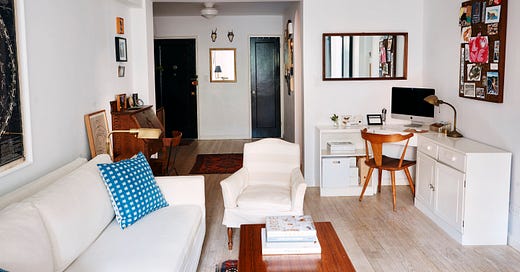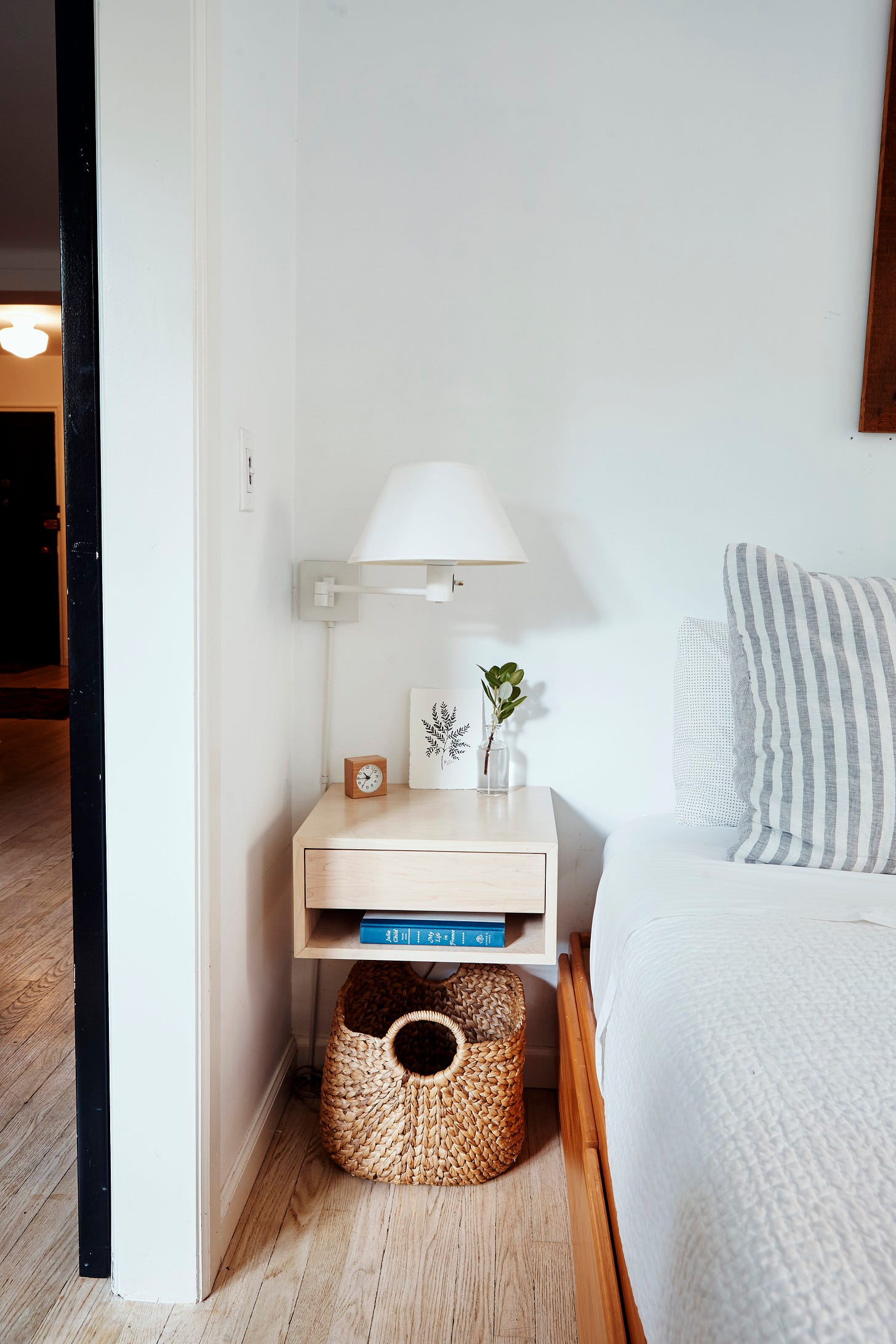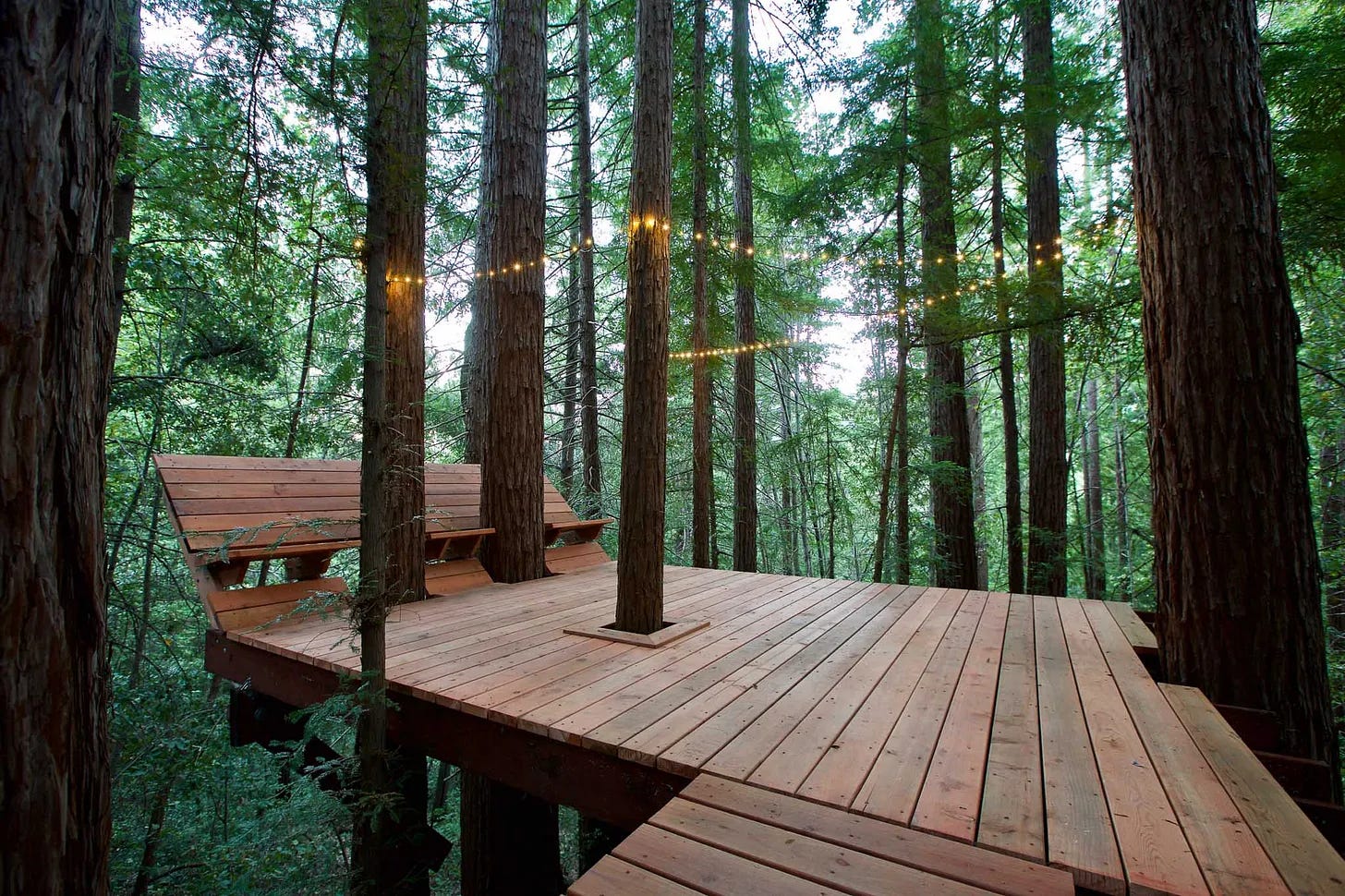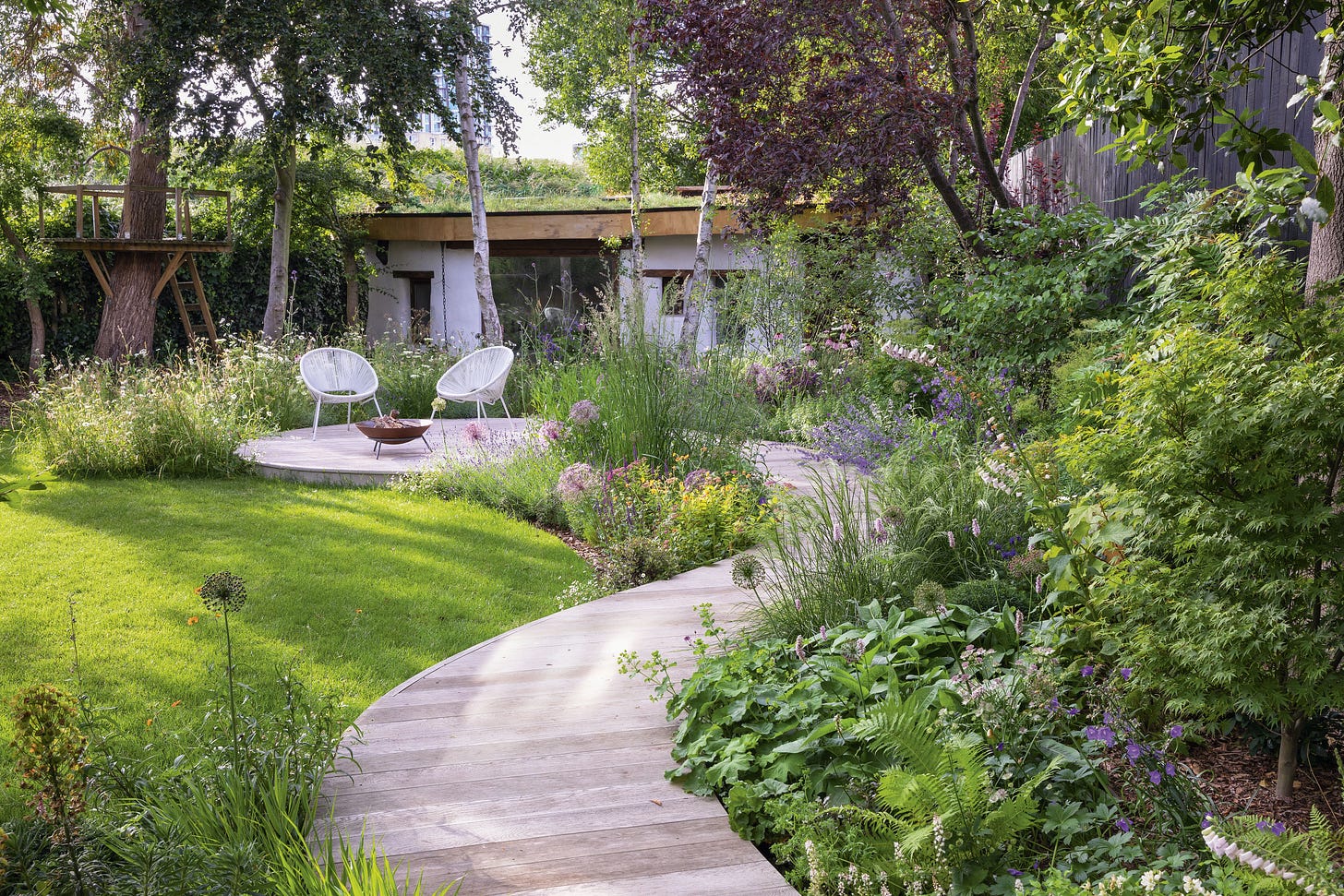The drying rack is full of clothes to one side of our living space; there’s another small pile of clean laundry to be folded on the couch. My son’s old car seat is sitting nearby ready to be given to a younger child. On the top of the sideboard there’s a roll of tape, a random rope, a book of paper airplane instructions, and a few paper airplanes. On the dining table, you’ll find my son’s pajama top, a card game, sunscreen, a whistle, and a coffee table book. Sound familiar?
In my home, this is actually pretty rare–not the state of mild clutter that’s a constant ebb and flow—but the fact that I woke up to it.
Most nights, after we’ve put our son to bed, my husband and I finish the dishes and then completely reset the house. Having both worked in restaurants, we jokingly call this our “side work,” the nickname for the restaurant tidying that servers are expected to do before they clock out like filling the salt shakers and marrying the ketchups. By the time the side work is all done, it is often time to get ready for bed (for my friends who can’t believe that we don’t watch television, this is why).
Resetting the house is not a fun chore, but it’s the secret to living small. For me, it’s also something more: It’s a way to set my family up for success.
What is your home’s baseline?
Merriam-Webster Dictionary’s definition of ‘baseline’ is "a line serving as a basis; especially: one of known measure or position used (as in surveying or navigation) to calculate or locate something.”
In the case of your home, the baseline is not the starting point of where you are today. Rather it is your house on its best day. Baseline is the way it looks when you’ve done a full tidy before guests come over, maybe even after a big trip to the Goodwill when everything feels light. It’s the ideal you’re always trying to get back to—and in a perfect world, we’d get back to baseline every day. In reality we probably only get close.
Why is the starting line important?
A baseline is important because it gives you a clear goal: You know what you are striving towards when you’re tidying up. For some people, especially parents of young kids, baseline has been obscured for so long that they can’t even picture what it is that’s worth taking the time to declutter and tidy for. You might not even know what your baseline is until you do the work to get back there.
I believe that a clutter-free, tidy home is worth the work.
For me, I feel my best when my home is at its best. When the house is tidy, I feel better prepared to face my day, I can focus. When it’s disorganized or the surfaces are cluttered, I tend to feel overwhelmed, I can’t quite think straight. For me, maintaining order is self care.
Find your baseline
Now, it’s time to get your house to the starting line. Tidy up like you would if important guests were coming to visit or if you were showing your house to a real estate broker. Get every space to its best self. If your house is on the more cluttered side right now, don’t try to get to baseline all at once. Instead, go room by room, getting each room show-worthy, and then making an effort to maintain that room as you work on the rest.
Focus on horizontal surfaces
As much as possible, your baseline should keep your horizontal surfaces (bureau tops, counters, table surfaces) clear. The flat surfaces in our homes, especially small homes, are where mess builds up, clutter hotspots, if you will. Whenever I keep books and a stack of magazines on our coffee table, they are like an invitation for more clutter to gather. With an empty coffee table as my baseline, I force myself to get everything off the surface each night and everything feels 10x more calm and orderly.
Restore order every night
I’m so sorry, but if you want the awesome feeling of a clutter-free home, you’re going to need to tidy up every evening, especially if you live in a small space. It’s the only way. Sure, you can take a day off and you can be more relaxed some days, but at the very least, you should at least be resetting your home to baseline 2 or 3 times a week. Even trying to do it all in one big sweep on the weekends lets too much disorder arise. You don’t want to get to the place where you have to spend a whole day getting back to baseline.
Once you’ve established baseline, push further
Everyone’s idea of tidy or what my friend Shira Gill recently deemed “clutter tolerance” is different—and that’s okay. But the aesthetic of our home is not the barometer for a good baseline. The way to know if you’ve found your optimal baseline is if it is easy to maintain.
Most people are trying to store too many things in their home–or they don’t have good systems to store them (this is especially true in smaller homes). And therefore maintaining that order you’ve created is too hard–it takes too much time and effort. The goal is to keep refining your baseline (decluttering, creating storage solutions) until tidying up every night is relatively easy, a 20-30 minute task—not a Herculean, hours-long effort.
So, let’s say you’ve gotten your kitchen to baseline: There’s no stack of papers on the countertop, everything is put away. Now it’s time to assess how your starting point can be improved. Look around: What spots look cluttered up? What could you do to streamline further? If you’re having trouble seeing what might change, try taking a photo of the room: It can help you see what spots are still congested. Is there a rarely used appliance that could get put away in a cabinet? A decorative item that is always in the way when you clean? Maybe you could thin the collection of spoons and spatulas in the utensil crock? Would a tray beneath the oils and vinegars make it easier to wipe the counters nightly?
Make everything easy to put away
This is the key to staying organized: It has to be easy to keep up your baseline. I’m guilty of not following this rule myself: If I Tetris the contents of our main closet just so it looks neat and tidy, but it’s impossible to maintain on the daily. So, it’s a constant cycle of tidy up, a slow descent into disorder, and then whipping things back into shape again. If something is difficult to put away, it’s probably because there’s too much stored in the place where it is meant to go (if your shirts only fit in the drawer when perfectly Kon Mari folded), or you’ve set up a system that’s impossible to maintain (hello, color-coded LEGO storage). Identify and work on the things that are hard to keep tidy.
The underlying question we’re asking is: How much stuff is the right amount for your space? The goal is to get to a place where the tidying takes less time. THIS is why we declutter: To gain back time.
This is all the advice you need to get started, but if you’re craving more, you’ll find next-level ideas for pushing the baseline further after the paywall, where you’ll find this week’s links. Thank you so much for reading LIVING SMALL. I hope you’ll share it with friends who might find it useful.
Play detective while you tidy
Think of your nightly side work as an opportunity to research your home. As you get into the habit of a nightly tidy-up, you’re going to encounter items that need to be put away. Here are four ways to play clutter detective while you work:
Make note of the objects that are always out of place. These items might be stored in the wrong place to begin with. For my family, this was shoes. I was constantly putting shoes back into the cubbies in our bedroom closet when I realized that maybe our everyday shoes could just live in the entryway in a basket. So much easier!
Zero in on the things that have no home. Are there items that you really have to think about where they should go? These things need to gain a permanent home so that you (and your family members) aren’t always trying to find a place to wedge them in.
Notice where you’re cramming. If you’re constantly squeezing or rearranging things in a particular area, you’ve got too much stored there. For me, this is the shelf where we store food storage containers and a few of my son’s toy bins (the Brio trains only fit in, if we arrange them just so). The solution: Edit a few things out until you’re not cramming.
Identify the problem areas. Make note of the places that tend to get messiest too. There might be a habit shift or a new system that can help with these. For example, I know my family could come up with a better system for our kid’s stuffed animals that he likes to sleep with: Making the bed is too hard, so maybe we need a bedside basket for the sleep stuffies?
Create a transitional zone
There are always going to be some items that don’t have a permanent place in your house: An online purchase that needs to be returned, library books, a gift that needs wrapping, the weekend newspaper, but that doesn’t mean they can’t have a designated home too. Things like a basket for mail or an “outbox” basket for packages near the door can help tame the transitional clutter in your home.
Tackle the hidden messes
I’ll never forget when Yumiko Sekine the author of the book Simplicity At Home suggested forcing yourself to look at your hidden messes, writing, “If you only have cabinets with doors, try removing the doors and see if that changes the way you organize and use your belongings.” You don’t need to take a screwdriver to the kitchen cabinet hinges, but imagine the doors gone: Would you like what you see? Tackling the out-of-sight disorder is the graduate school level of refining your baseline.
Finally, elevate the baseline
Another way to improve baseline has nothing to do with decluttering or tidying, but rather with restyling what you already own. Going back to our hypothetical kitchen, ask yourself what details could be elevated to make your baseline more appealing. Perhaps you decant your dish soap into a pretty pump bottle or you oil your wooden spoons so they look new again.
This part may sound frivolous to some people, but I believe it is important because any time you can elevate the appearance of your home–whether that is bins, your baskets, your file folders, your recycling bin—it reinforces the idea that “This is my home. I want to take care of it and keep it organized.”
As a last resort: Outsource
If you do all this and it is still too much, maybe you need help. You can hire someone to clean your home, so you can focus on maintaining order. You could hire a professional organizer to help you improve your systems. Outsourcing can also be less direct: You can pick up prepared foods or order takeout (and avoid the related meal making clean-up) on laundry night. You could have your children eat school lunch and outsource all the mess of meal making and lunchbox unpacking. If you can’t face another day of messy kid rooms, get them to play somewhere else, like the playground or library.
3 More Things:
New-to-me home design Substacks
I was delighted to discover that Jeff Waldman of
has a Substack! An architectural designer and furniture maker, I have long-admired Jeff’s work, including the design of this tiny A-frame structure, this tree fort, and this Judd-inspired daybed. I also enjoyed poking around the archive of (a great name), which is all about systems for your home.What happens to all the stuff we return?
This New Yorker article explores the real cost of our free shipping, free returns shopping culture. “Most online shoppers assume that items they return go back into regular inventory, to be sold again at full price. That rarely happens.” If this surprises you, the article is a must read, and even if you already knew this, there’s a lot to learn. (Also, don’t you kinda love that The New Yorker is still capitalizing Internet.)
Meadows on my mind
Loved the photos of this dreamy backyard mini meadow in North London. One of my favorite nonprofits offers advice on how to make a meadow. And I am 100-percent on board with the call to rewild the national mall.









This will probably wear off as I've only decluttered my apartment recently, but I love resetting my home each night. I like to hand wash the dishes rather than put them in the dishwasher, clear the kitchen trash (the garbage can seems to fill up fast), straighten the contents of the fridge, return clothes to the closet that I lazily hung on the hook on the back of the bedroom door. I get a thrill out of the look of the place after I've reset. It becomes a welcoming space to wake up to.
Thank you for the idea of elevating the baseline. Having spent two months decluttering top to bottom and every crevice in between, I'd shunned beautification. Yes, it would be nice to have an attractive soap and lotion dispenser to replace the drugstore bottles. And maybe I don't need that metal meat tenderizer given that I'm a vegetarian, making room in the canister for a groovy new spatula. You've given me delicious ideas. Thanks.
I am so on board with all of these recommendations! Doing lots of micro-tidying does indeed yield more free time overall. And if it doesn't, you probably have too much stuff. I couldn't bear to finish that New Yorker article...so depressing, but good information to know.
Thank you for the shout-out! I'm enjoying your writing immensely.